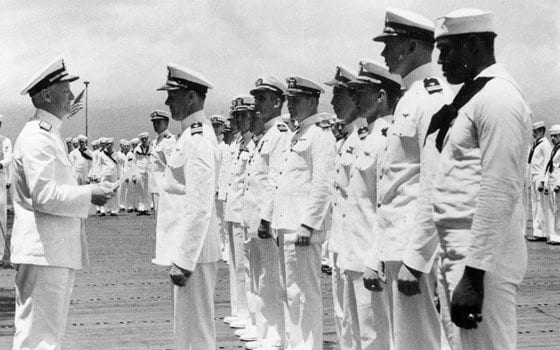

Doris “Dorie” Miller was among four Navy sailors commemorated for their bravery and distinction with a U.S. Postal Service first-class stamp.
The first black American hero of World War II, Miller (1919-1943) became an inspiration for his actions at Pearl Harbor on Dec. 7, 1941. Serving aboard the battleship “West Virginia” as a mess attendant — the only job open to blacks at the time — Miller helped rescue scores of shipmates wounded or trapped in wreckage.
Miller was later ordered to the bridge to help move the ship’s mortally wounded captain. Never trained in its operation, he manned an unattended .50-caliber Browning anti-aircraft machine gun until he ran out of ammunition and was ordered to abandon ship as fires raged out of control.
Born in Waco, Texas, Miller later described firing the machine gun during the battle, a weapon that he had not been trained to operate. “It wasn’t hard,” he said. “I just pulled the trigger and she worked fine. I had watched the others with these guns. I guess I fired her for about fifteen minutes. I think I got one of those Jap planes. They were diving pretty close to us.”
During the attack, Japanese aircraft dropped two armored piercing bombs through the deck of the battleship and launched five 18-inch aircraft torpedoes into her port side. Heavily damaged by the ensuing explosions, and suffering from severe flooding below decks, the crew abandoned ship while West Virginia slowly settled to the harbor bottom.
Of the 1,541 men on West Virginia during the attack, 130 were killed and 52 wounded. Subsequently repaired and modernized, the battleship served in the Pacific theater to the end of the war in August 1945.
Secretary of the Navy Frank Knox commended Miller on April 1, 1942. Nearly two months later, Miller received the Navy Cross from Fleet Admiral Chester W. Nimitz.
“This marks the first time in this conflict that such high tribute has been made in the Pacific Fleet to a member of his race and I’m sure that the future will see others similarly honored for brave acts,” Nimitz said at the time.
Later that year, Miller reported to USS Indianapolis and subsequently returned to the west coast of the United States. Assigned to the newly constructed USS Liscome Bay and promoted to Officer’s Cook Third Class, Miller was on board that escort carrier during Operation Galvanic, the seizure of Makin and Tarawa Atolls in the Gilbert Islands. Liscome Bay’s aircraft supported operations ashore. At 5:10 a.m. on November 24, while cruising near Butaritari Island, a single torpedo from Japanese submarine I-175 struck the escort carrier near the stern.
The aircraft bomb magazine detonated a few moments later, sinking the warship within minutes. Listed as missing following the loss of that escort carrier, Miller was officially presumed dead on Nov. 25, 1944, a year and a day after the loss of Liscome Bay. Only 272 Sailors survived the sinking of Liscome Bay, while 646 died.
Miller’s stamp is based on a 1942 photograph and depicts the crest of the destroyer escort USS Miller commissioned in 1973. Actor Cuba Gooding Jr., portrayed Miller in the 2001 movie “Pearl Harbor.”
The other Navy men awarded a stamp were William S. Sims, Arleigh A. Burke and John McCloy.






